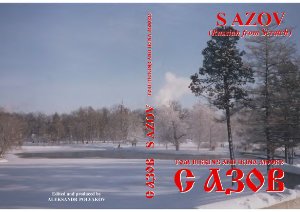School of Hamanities, Languages and Sociences, University of
Wolverhampton, - 2003. - 526 p.
The authors, Tom Dickins and Irina Moore, decided to write ‘S azov’ (Russian from Scratch) because of the lack of suitable communicative ab initio Russian language courses for more mature leaers. "S azov" has been used extensively with their own degree-level students, and has thus benefited from considerable testing in practical classroom situations. It is appropriate for a wide range of leaers, from school pupils with a background in foreign languages to evening-class students and undergraduates and postgraduates.
The textbook consists of an introductory chapter and twenty further chapters based on themes which exemplify and consolidate a series of new linguistic concepts. Particular emphasis is placed on the use of authentic up-to-date materials, such as advertisements, newspaper clippings, timetables, tickets, official forms and recent photographs, and on the creation of meaningful and relevant contexts for language leaing. Wherever possible, the students are asked to deduce unfamiliar syntactic and morphological principles for themselves from regular paradigms, before being required to apply the new rules or to cope with irregularities.
Each chapter begins with a summary of the competences which the students will acquire and with a list of the main points of grammar which are to be introduced. Roughly equal weighting is given to the four skills (speaking, reading, listening and writing), which are developed through a series of lexical and interactive activities, including memory games, crosswords, gap-filling tasks and role plays. Vocabulary glossaries are provided at the foot of each page, where necessary, and there is a comprehensive alphabetical Russian-English and English-Russian vocabulary list at the end of the course. There is also a grammar section at the end of each chapter, with more detailed explanations and grammatical exercises.
Introductions.
An object lesson.
Work / Nationality.
At the airport.
Shopping for food.
I can’t hear you very well!
At the hotel.
Russian cuisine.
Now and then.
Hobbies and interests.
Health.
Education.
My family and (other) animals.
The weather.
A horrible sight (or aspect? ).
In the town.
Bon voyage!
At home.
Personal information.
A further step in reading and writing.
Listening passages.
Vocabulary.
The authors, Tom Dickins and Irina Moore, decided to write ‘S azov’ (Russian from Scratch) because of the lack of suitable communicative ab initio Russian language courses for more mature leaers. "S azov" has been used extensively with their own degree-level students, and has thus benefited from considerable testing in practical classroom situations. It is appropriate for a wide range of leaers, from school pupils with a background in foreign languages to evening-class students and undergraduates and postgraduates.
The textbook consists of an introductory chapter and twenty further chapters based on themes which exemplify and consolidate a series of new linguistic concepts. Particular emphasis is placed on the use of authentic up-to-date materials, such as advertisements, newspaper clippings, timetables, tickets, official forms and recent photographs, and on the creation of meaningful and relevant contexts for language leaing. Wherever possible, the students are asked to deduce unfamiliar syntactic and morphological principles for themselves from regular paradigms, before being required to apply the new rules or to cope with irregularities.
Each chapter begins with a summary of the competences which the students will acquire and with a list of the main points of grammar which are to be introduced. Roughly equal weighting is given to the four skills (speaking, reading, listening and writing), which are developed through a series of lexical and interactive activities, including memory games, crosswords, gap-filling tasks and role plays. Vocabulary glossaries are provided at the foot of each page, where necessary, and there is a comprehensive alphabetical Russian-English and English-Russian vocabulary list at the end of the course. There is also a grammar section at the end of each chapter, with more detailed explanations and grammatical exercises.
Introductions.
An object lesson.
Work / Nationality.
At the airport.
Shopping for food.
I can’t hear you very well!
At the hotel.
Russian cuisine.
Now and then.
Hobbies and interests.
Health.
Education.
My family and (other) animals.
The weather.
A horrible sight (or aspect? ).
In the town.
Bon voyage!
At home.
Personal information.
A further step in reading and writing.
Listening passages.
Vocabulary.

